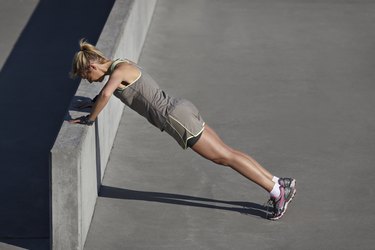
A fractured back or spinal fracture is often due to an accident or osteoporosis. The following exercises for fractured vertebrae will strengthen your core, enhance your balance and improve overall bone health. You should also know what exercises to avoid to prevent further injuries.
Causes of Spinal Fractures
Video of the Day
An adult spine contains 24 vertebrae, or bones, that are stacked on top of each other, according to the American Academy of Orthopaedic Surgeons (AAOS). Fun fact: You are actually born with 33, but some fuse together as you get older. The vertebrae create a bony canal that helps protect your spinal cord.
Video of the Day
You may fracture your spine from a fall or other traumas, such as a car accident. A tumor can also cause vertebral fractures. Osteoporosis, or weakening of the bones, is the most common cause of vertebral compression fractures, especially in women who are over the age of 50, reports Cedars Sinai.
Symptoms of a fractured back include a sudden onset of back pain that is worse with standing or walking. Patients may also experience limited mobility, as well as loss in height and deformities, including a dowager's hump.
Read more: Core Strengthening Exercises for Seniors
Depending on the type of fracture and severity, some people may require a back brace for six to eight weeks to restrict movement so the fracture will heal. Surgery may be indicated in some instances. Most patients will get better within three months after a vertebral compression fracture, says the AAOS.
Physical therapy for a broken back can help strengthen your core muscles, reduce pain and prevent future injuries. Your therapist can develop a custom treatment plan that may include specific exercises for wedge fracture of the back.
Exercises for Fractured Vertebrae
Before you start any exercise program, make sure you are cleared by your doctor and know what you can and can't do for your specific injury. If any exercise causes an increase in pain, stop and talk to your doctor. He or she may initially want you to have physical therapy for your broken back, followed by a home exercise program.
Start with the following exercises to strengthen your core and lower body, recommends the AAOS.
- Abdominal bracing: Lie on your back with your knees bent. Tighten your abdominal muscles and flatten your lower back on to the floor. Hold for 15 seconds and repeat.
- Hip bridge: Lie on your back with knees bent. Tighten your abdominal muscles and lift your pelvis until your body is in a straight line. Hold for 15 seconds and repeat.
Progress to functional exercises that work your core and lower body. Perform the following resistance exercises twice a week, with eight to 12 reps per set, as described in a March 2014 review in Osteoporosis International:
- Heel raises
- Sit-to-stand exercises with a chair
- Squats
- Wall push-ups
- Bow-and-arrow pull: This exercise helps improve back muscles to promote good posture. While sitting, hold an exercise band out in front with arms extended. Pull one side of the tube back until it is close to your shoulder. Repeat to the other side.
You may also perform thoracic stretches. Lay on your back on the floor or a firm mattress for five to 10 minutes per day. Use a small pillow under your head as needed. You can have your legs straight or with a pillow underneath.
Rest your arms at your sides as you feel your shoulders go back into the floor. This helps stretch out the tight front chest muscles to promote good posture and extension.
Aerobic Activity Is Important
In addition to resistance and balance exercises, you should also incorporate weight-bearing aerobic exercise into your routine, says Osteoporosis International. Aim for 150 minutes of moderate physical activity per week. Walking or tai chi are recommended.
As far as yoga, there are some moves that are good for balance and flexibility. However, those that involve flexion or twisting should be avoided, points out the Mayo Clinic.
Read more: 3 Tai Chi Moves for Beginners
Balance exercises should be done daily to help you regain your stability and strengthen your core. Start by holding on to a chair and gradually reduce your reliance on holding on for support.
- One-legged stand
- Stand on heels or toes
- Tandem stance: Place the heel of your left foot against the toes of your right foot.
There are some movements and exercises you should avoid after a fractured back, notes Osteoporosis International. Steer clear of high-impact exercises that can jostle your back, such as jumping or running. Avoid bending over at the waist and twisting your waist.
- American Academy of Orthopaedic Surgeons: "Osteoporosis and Spinal Fractures"
- Cedars-Sinai: "Spinal Compression Fractures"
- American Academy of Orthopaedic Surgeons: "Spine Conditioning Program"
- Osteoporosis International: "Too Fit to Fracture: Exercise Recommendations for Individuals With Osteoporosis or Osteoporotic Vertebral Fracture"
- Mayo Clinic: "Association of Yoga Exercises and Vertebral Compression Fractures"
Was this article helpful?
150 Characters Max
0/150
Thank you for sharing!
Thank you for your feedback!